Complete Guide to Kite Surf Equipment Essentials

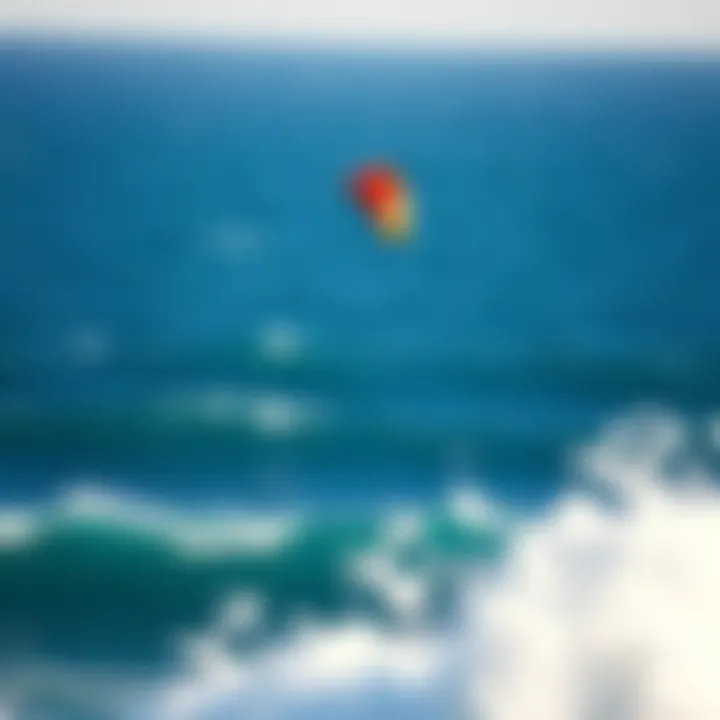
Intro
Kite surfing is much more than just a thrilling way to spend time on the water; it’s an intricate dance between rider, wind, and waves. To fully enjoy this adventure, having the right gear is essential. The world of kite surf equipment can be a bit daunting due to the variety of options available. From kites to boards, harnesses, and safety equipment, each piece plays a vital role in creating a memorable experience on the water. Whether you’re a novice eager to dip your toes into the sport or a seasoned veteran looking to refine your setup, understanding the components of kite surf equipment is key.
In this guide, we’ll explore crucial aspects of kite surfing gear. You’ll learn about the different types of kites, how to choose the right board to suit your style, and much more. Plus, we’ll delve into safety where every kite surfer should feel secure while riding the waves.
Buckle up, as we will set the stage for your kiteboarding journey!
Gear Selection
Picking the right gear is akin to laying down the foundation for a grand house. It is an absolute necessity if you want the building to stand strong against winds and tides.
Types of Kites
Kites are the heart and soul of kite surfing. Understanding the type of kite suitable for your level, style, and conditions can greatly enhance your experience. There are several types, and each comes with its unique characteristics:
- LEI (Leading Edge Inflatable): These kites are the most commonly used in kiteboarding. They have inflatable chambers creating a rigid structure. They offer excellent versatility and are ideal for both new and seasoned riders.
- C-Kites: With their distinctive shape, these kites are favored for performance tricks. They generate a lot of power in one spot, making them excellent for unhooked tricks but they demand more skill to manage.
- Bow Kites: These are known for their large area and high lift capabilities. They are user-friendly and perform well in a variety of wind conditions.
- Foil Kites: Unlike traditional kites, foil kites use a series of cells to catch the wind. They’re efficient and can be used in light wind conditions, but require a bit of getting used to.
When deciding on the type of kite, consider wind conditions and your skill level. Beginners might opt for a stable LEI while more advanced surfers might lean towards a C-kite for its trick capabilities.
Choosing the Right Board
Just as a knight wouldn't go into battle without the right sword, a kite surfer must select the right board to complement their kites. Here are the types of boards to consider:
- Twin-Tip Boards: The most popular option, these boards are symmetrical and can be ridden both ways. They are great for freestyle and are adaptable for rough conditions.
- Directional Boards: Resembling a surfboard, these are ideal for downwind riding and wave surfing. They offer a different feel and are less common among beginners.
- Foil Boards: These boards elevate above the water using a hydrofoil attached below. Ideal for those looking to ride in lighter winds, they provide a unique kiteboarding experience.
Keep in mind the following factors while selecting your board:
- Size: A larger board offers more stability and is better suited for beginners, while smaller boards are more suitable for advanced maneuvers.
- Weight: Lighter boards can enhance performance and make tricks easier, but often come with a higher price tag.
Choosing a kite board may seem like a daunting task, but with the right guidance, it can be quite straightforward.
"Good gear isn’t just about performance; it’s also about confidence on the water. Choose wisely."
In the next section, we will dive into skill development by focusing on essential techniques and tips to help riders progress further in their kiteboarding journey.
Understanding Kite Surfing
Kite surfing combines the strength of the wind with the fluid dynamics of water, offering a unique blend of thrill and skill. It's more than just a sport; it’s a lifestyle for many. Gaining a thorough understanding of kite surfing is essential. Many newcomers encounter challenges due to a lack of foundational knowledge. Understanding not only the equipment but the environment can greatly increase one's safety and enjoyment in this exhilarating activity.
A key element to grasp is how the wind interacts with kites and, subsequently, how it affects maneuvers across the water. Knowing the wind speed and direction can dictate the success of each session. In addition, understanding the relationship between wind conditions and the type of kite or board you use can prevent mishaps and ensure a smoother ride.
Furthermore, kite surfing has its communities and cultures, often based on geographical locations and wind conditions. This aspect can influence style and preferences, enriching the sport's fabric. Addressing these points provides a foundational framework that helps kite surfers—be they seasoned veterans or enthusiastic newcomers—navigate the nuances of kite surfing more effectively.
The Basics of Kite Surfing
At its core, kite surfing revolves around a few essential components: the kite, board, harness, and safety gear. When you strip it down, kite surfing is about harnessing the wind to propel yourself across the water, offering an adrenaline rush like no other. Understanding how each component works synergistically is crucial for a smooth experience.
- The Kite: The kite is your primary source of power. It catches the wind and translates that energy into thrust. Kites come in various shapes and sizes, designed for different conditions and rider preferences.
- The Board: This is where you stand. Boards vary in style, shape, and size, affecting your performance and comfort on the water. Choosing the right board complements your kite choice and skill level.
- Harness: The harness connects you to the kite, allowing you to manage power more effectively and reduce strain on your arms. It's important for it to fit well and feel comfortable.
- Safety Gear: Helmets, impact vests, and leashes can make a significant difference in keeping you safe while enjoying the thrill of kite surfing.
The basics are foundational, but the learning doesn’t stop here; understanding wind patterns, water currents, and even weather systems can further enhance one’s kite surfing skills and enjoyment.
The Evolution of the Sport
Kite surfing has come a long way since its origins in the late 1970s and early '80s. Initially a niche activity, it has transformed into a globally recognized sport with dedicated communities, competitions, and a wealth of gear tailored to various styles and conditions.
Originally, the first kite surfers used simple kites that were primarily designed for fun rather than performance. Over the years, advancements in technology and materials reshaped the landscape of kite surfing.
- Kite Design: Early kites were often bulky and difficult to handle, whereas today’s kites are lightweight, responsive, and often come with advanced features such as adjustable bridles and different control settings.
- Surfboards: The evolution of boards is also noteworthy. Boards have become specialized for specific types of riding, with variations for freestyle, wave riding, or racing. The shapes and materials have also contributed significantly to performance enhancements.
- Safety Innovations: The development of safety gear has been crucial. Quick-release systems and improved harness designs have become industry standards, vastly improving rider safety.
In summary, as kite surfing has evolved, it has become not only more accessible but also safer and more enjoyable for a broader audience. This continuous evolution plays a vital role in understanding the sport today.
Essential Kite Surf Equipment
Kite surfing is an exhilarating sport that demands the right equipment for both safety and performance. Understanding the essential gear is more than just having a good time on the water; it can significantly affect your experience. Each component—from kites to harnesses—plays a crucial role in how you maneuver through the waves, and selecting the appropriate equipment can make all the difference.
Kites
Types of Kites
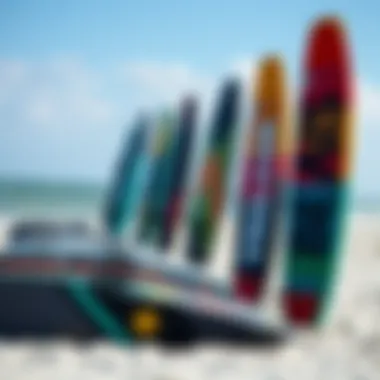
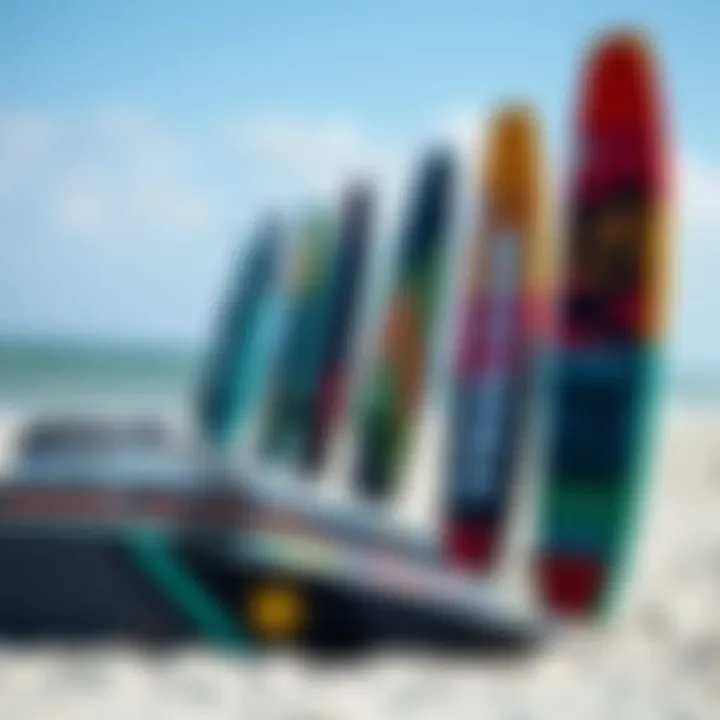
When it comes to kite surfing, kites are the heart of your setup. There are various types of kites, including flat kites, bow kites, and delta kites, each designed to perform under different wind conditions. Flat kites, for instance, are great for high-speed riding and offer a large wind range, making them a popular choice for both novices and experts. A unique feature of delta kites is their ability to relaunch easily from the water. This advantage is why many beginners find them easier to use.
On the flip side, each kite type has its own disadvantages, like specific wind conditions where they perform best. However, understanding these nuances can enhance your overall performance in the sport.
Choosing the Right Size
Selecting the right size of your kite is essential. A kite that's too large can easily become unmanageable in strong winds, while a small kite might struggle to lift you up in light conditions. The ideal size depends on your weight, riding style, and local wind conditions. If you're on the heavier side, going for a larger kite may be beneficial for catching enough wind. It’s intriguing how the right size can transform your ride—turning frustration into effortless gliding.
However, a kite that's overly large can lead to risks. Thus, having a clear understanding of your local weather patterns and your skill level can drastically improve your safety and enjoyment on the water.
Material Considerations
Material is another vital aspect to consider for your kite. Most kites are made from ripstop nylon or similar fabrics, which are lightweight yet durable. Ripstop is particularly notable for its resistance to tearing—a crucial factor considering the harsh conditions you may encounter on the water. While the lightweight aspect allows for easy maneuverability, it’s essential to check if the material can withstand your local conditions.
A downside might come from less durable materials, which can tear easily and lead to costly repairs. Thus, the investment in quality materials often pays off in terms of longevity and performance.
Boards
Different Board Types
Boards are also pivotal in kite surfing. You’ll find various types, such as twin-tip boards and surfboards. Twin-tip boards are favored for their versatility and ease of use, making them a common choice for freeriding. They let you ride in both directions, which is a big plus for beginners. Conversely, surfboards are typically used for waves and offer a different riding experience, being designed more for carving and turning.
The choice of board can influence your riding style and how well you can progress in the sport. There are times when tackling big waves requires a more specific type of board, showcasing how important it is to align your choice with your riding ambitions.
Selecting the Correct Dimension
Choosing the right dimensions for your board, including its length and width, is fundamental to your overall performance. For instance, a wider board may stabilize you better during choppy waters, but it could slow you down in smoother conditions. Beginners may benefit from slightly longer and wider boards as they offer more surface area for balance.
The dimensions play a direct role in how you perform tricks or transition between maneuvers. So, having an understanding of your personal riding style and the conditions you expect can guide your choice.
Foot Strap vs. Bindings
Delving into the foot attachment options—foot straps and bindings—is crucial. Foot straps offer a more accessible way to secure feet while enabling quick access to the board. This can be particularly beneficial for novices or those who prefer to make quick adjustments. In contrast, bindings offer a more locked-in feel, ideal for advanced riders focusing on jumps and tricks.
However, bindings can make it tricky to exit the board quickly, especially in difficult water situations. Weighing the benefits of each style against your skill and comfort level can be key in making a wise choice.
Harnesses
Types of Harnesses
Harnesses are another indispensable piece of kite surf equipment. They mainly come in two types: waist harnesses and seat harnesses. A waist harness sits higher on your body, allowing for greater mobility, especially during aggressive maneuvers. On the other hand, a seat harness offers more support and is generally better for beginners, as it distributes the load more evenly across your lower body.
This distinction is crucial because the choice will affect your comfort and control while riding. Many riders might lean towards a waist harness for its mobility, yet the added support of a seat harness shouldn’t be overlooked, especially in challenging conditions.
Adjustability and Fit
The fit of your harness is another critical factor. An adjustable harness that molds well to your body can significantly enhance the riding experience. It’s vital to ensure that the harness doesn’t chafe or pinch during prolonged rides. A loose harness may slide up or down, limiting your freedom and comfort.
Many brands offer customizable options, allowing you to tighten or loosen as needed for optimum fit. Achieving this perfect alignment can greatly reduce fatigue, extending your enjoyment on the water.
Safety Features
Finally, the safety features of your harness can't be ignored. Look for harnesses that come with quick-release mechanisms, which can be a lifesaver in emergencies. Safety lines and padding can also contribute to your overall protection during a fall or mishap. Ignoring these features may threaten not just your style and performance but could also lead to serious injuries.
Being aware of the safety aspects can empower you to enjoy the exhilarating ride without unnecessary worries, ultimately enabling you to focus on your technique and experience out there.
Safety Equipment and Accessories
Safety equipment is non-negotiable in kite surfing. The thrill of riding the wind and waves can quickly turn dangerous without the right protective gear. Safety equipment and accessories ensure that every kiteboarding adventure is enjoyable while minimizing the risk of injury. This section covers key elements of kiteboarding safety equipment, their benefits, and the thoughtful considerations you need to keep in mind.
Safety Leashes
A safety leash is a vital component of kite surfing safety. It connects the rider to the kite, enabling you to have control even when things go awry. If you experience a crash or if the kite gets away, the safety leash acts as a lifeline, preventing total separation from your gear.
Why it matters: With a properly functioning safety leash, the chances of a runaway kite causing harm decrease significantly. Imagine a wild kite drifting into the beach where people walk—definitely not an ideal scenario.
- Key consideration: The durability of the leash. Look for options made from strong materials for long-lasting performance.
- Common styles include: fixed and quick-release leashes, each catering to specific rider preferences and experiences.
Impact Vests and Helmets
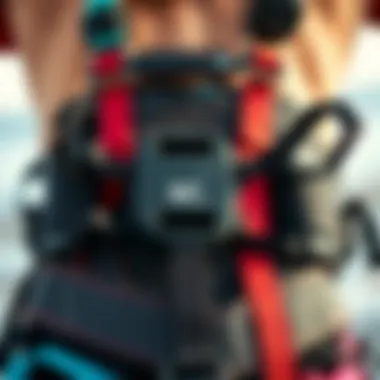
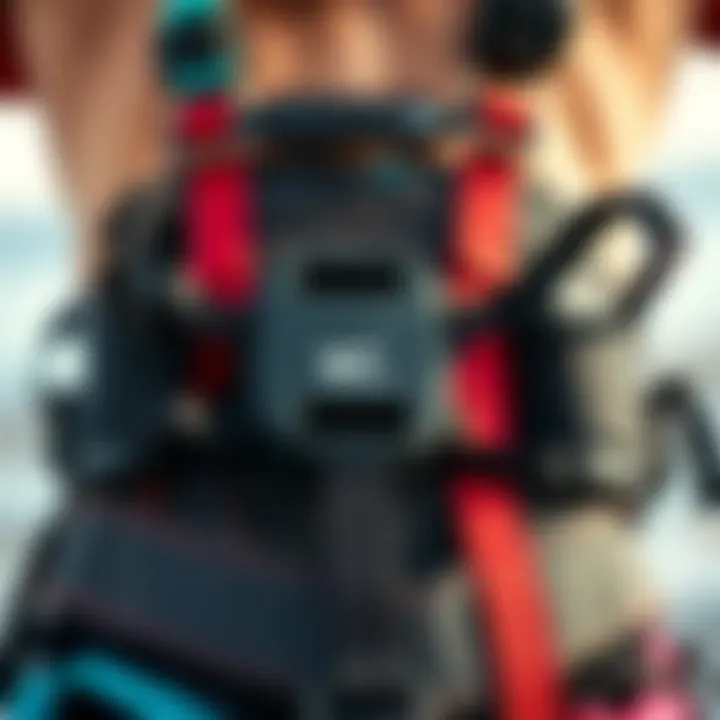
When you step onto the water, wearing an impact vest and helmet can be the difference between a minor bump and a serious injury. These pieces of equipment offer crucial protection against falls, especially for beginners and those mastering tricks.
- Impact vests: These are designed to absorb impact on landing and provide some flotation. Their bulk can also help keep you afloat if you wipe out unexpectedly.
- Helmets: Protecting your head is a must. Good helmets ensure that even the roughest of spills don’t result in concussions or worse.
Tip: Choose vests and helmets that fit snugly without impeding movement. An uncomfortable fit can lead to distractions or worse, potential accidents.
Bar and Lines
Understanding Control Bars
The control bar is your main interface with the kite. It serves as the steering mechanism, allowing you to control power and direction while riding. It's crucial to familiarize yourself with how your chosen control bar works, as this affects overall riding performance.
- Key characteristic: Most control bars come with adjustable widths and are made of lightweight, yet durable materials.
- Unique feature: Many modern bars incorporate features like safety systems that can be activated in seconds.
- Advantages: They enhance your control over the kite and, by extension, your overall safety.
Line Types and Lengths
Lines play an essential role in kite surfing as they transmit input from the control bar to the kite itself. Understanding the various line types and lengths can significantly elevate your kiteboarding experience.
- Types: You’ll encounter Dyneema or Spectra lines, which offer excellent strength and low stretch, making them ideal for higher performance kiting.
- Lengths: Lines can usually be found in 20m, 22m or longer options. The choice of length can affect how the kite performs in different wind conditions and play a crucial role in your skill level.
Remember: The right setup can be the difference between effortless cruising and a battle against the wind.
Regular Maintenance of Lines
Maintaining your lines is not only about prolonging their life—it's about ensuring safety on each ride. Frayed or damaged lines can lead to catastrophic failures while out on the water.
- Key characteristic: Pay attention to any signs of wear such as frays or knots.
- Unique feature: Many advanced kites come with color-coded lines, which help in quick checks and repairs.
- Advantages: Regular checks can prevent unexpected issues—saving you time, hassle, and potential injury during your sessions.
To sum it up, safety equipment and accessories are fundamental in kite surfing. Investing time in understanding and selecting the right gear might not seem adventurous but thinking ahead will pay off on the water. With the right tools and knowledge, you can enjoy the thrill with confidence.
Evaluating Equipment Performance
When it comes to kiteboarding, performance evaluation isn’t just a box to tick. It directly affects your experience on the water and can even influence your safety. With ever-changing conditions, assessing how your gear performs becomes pivotal. Consider this: you’re out on the waves, wind howling, and you want every bit of equipment working harmoniously. Understanding performance not only enhances your enjoyment but also helps in making critical equipment choices.
Wind Conditions and Gear Compatibility
Let's dive into one of the most crucial aspects of performance evaluation: wind conditions. The wind is not just an element; it’s your ally in kiteboarding. You might be tempted to ride regardless of the conditions—often leading to mishaps or underperformance.
Each kite has a wind range, indicating the speeds at which it performs optimally. A kite designed for strong winds will not fare well in light breeze, and vice versa. Knowing the compatibility between your kite and the wind conditions is essential. It’s not just about personal preference but about safety. Here are a few points to keep in mind:
- Optimal Wind Range: Check the specifications from the manufacturer. Generally, if the wind sits comfortably within the recommended range, your gear is set for performance.
- Wind Fluctuations: Winds can be fickle. On a day when conditions seem perfect, gusts may come out of nowhere. If you're not aligned with your gear's capabilities, expect an untimely dip or unwanted spins.
- Kite Size Matters: Larger kites are more suited for lighter winds, while smaller kites perform well in stronger winds. Always choose based on the forecast and your own experience level.
Understanding these elements can prevent unpleasant surprises when you’re out on the water. A good grasp on the wind will elevate not just your performance but your confidence too.
Understanding Performance Metrics
Performance metrics encompass various factors that give you insight into how well your gear is functioning in real-time. By considering these metrics, kiteboarders can adjust their riding style, and refine technique.
Here’s a closer look:
- Speed and Acceleration: Evaluating how quickly you can reach top speeds or how responsive your equipment is to your movements can significantly influence your overall experience.
- Stability and Control: A stable kite is essential, especially in gusty conditions. Performance metrics here relate to how well the kite maintains its shape and orientation. You can really feel the difference when it comes to control.
- Lift and Glide: This relates to how well your kite can catch and maintain elevation, particularly when you’re attempting jumps. A kite that offers better lift will give the rider a smoother experience during tricks.
Understanding and leveraging these metrics can lead to improved performance on the water. The world of kiteboarding is exhilarating, but to ride the crest of that wave, you need your equipment to perform at its absolute peak. Remember, it’s about creating harmony between you and the elements.
Maintenance and Care for Kite Equipment
Taking care of your kite equipment isn’t just about keeping it looking sharp; it’s essential for safety and performance. For kiteboarders, proper maintenance often translates to enhanced longevity and reliability of gear. After all, when you’re out on the water, you want your equipment to perform its best without hiccups. The intricacies of maintenance encompass various activities, from systematic inspections to proper cleaning and storage, making it a vital part of any kiteboarding enthusiast's routine.
Regular Inspection Procedures
Regularly inspecting your kite gear can spot potential issues before they develop into serious problems. Here are some key areas to focus on during inspections:
- Kite Canopy: Check for rips, tears, or abrasions. Look closely at stitching, as a little fray can lead to a big tear.
- Lines and Connections: Inspect your lines for any signs of wear or fraying. These are crucial for control. Confirm that all connections, like knots and pigtails, are secure and in good condition.
- Pump: Ensure that the pump is functioning. Look out for any cracks or leaks in the pump or hoses. A faulty pump can ruin your day out on the water.
- Board and Straps: Check the board for any cracks that could compromise its integrity. Foot straps should also be tight and secure to avoid slipping.
Perform these checks after every few sessions and right before significant outings. Embracing this routine can save you from unnecessary troubles down the line.
Cleaning and Storage Tips
Cleaning and storing your kite gear properly after use ensures it remains in good condition, ready for your next adventure. Here’s how you can achieve that:


- Rinse with Fresh Water: After every use, especially in saltwater conditions, rinse your kite equipment with fresh water. Salt can corrode and damage materials if not removed promptly.
- Dry Thoroughly: Never store wet gear, as it can develop mold and mildew. Lay your kite flat to dry in a shaded area to avoid direct sunlight, which can degrade materials.
- Storing Your Kite: Fold your kite carefully and keep it in a cool, dry place to prevent creasing or stressing out the material. Use a specific bag to protect it from dust and damage.
- Gear Nesting: If you have multiple kites and boards, nest them to save space. Place lighter and less-used items at the bottom of your storage pile.
- Avoid Compression: When storing a board, avoid stacking heavy equipment on top of it. This might cause unwanted warps.
In summary, maintenance and care of kite equipment are critical steps in ensuring seamless kiteboarding experiences. Regular inspections and mindful cleaning are the golden tickets for extending the life and performance of your gear, ultimately leading to more enjoyable days spent riding the waves.
"An ounce of prevention is worth a pound of cure." Keeping this proverbial wisdom in mind, engage in regular maintenance to safeguard your kite gear and yourself.
Technological Advances in Kite Gear
The world of kite surfing is ever-evolving, primarily driven by advancements in technology. This evolution not only enhances performance but also significantly improves safety and overall user experience. As kiteboarders, instructors, and enthusiasts, understanding these advances can make a profound difference in your kiteboarding adventures. Not only do technological innovations help in achieving better speed and maneuverability, but they also make the sport more accessible to newcomers.
New Materials and Designs
In recent years, kite manufacturers have turned towards utilizing more durable and lightweight materials. For instance, the shift from traditional ripstop nylon to advanced synthetic fibers like Dyneema and Spectra is notable. These materials boast superior strength-to-weight ratios, meaning they can withstand harsher conditions without sagging or losing integrity, which could be risky when you’re harnessing the power of the wind.
The designs of kites have also progressed immensely. Now, you will find kites with smarter shapes that allow for greater lift and better control during aerial maneuvers. The arcs of the kites are often developed using computer-aided design, allowing for precision engineering. This careful design leads to increased responsiveness; when you pull on the lines, the kite reacts almost instantaneously.
"The kitesurfing gear of today is a far cry from the braces of decades past, it's like upgrading from a flip phone to a smartphone!"
These advancements in materials and designs can translate into tangible benefits:
- Enhanced performance: Improved aerodynamics leads to better glide and acceleration.
- Higher durability: Kites can now last longer in tough conditions, reducing the need for frequent replacements.
- Weight reduction: Lighter kites are easier to control, improving overall handling.
Smart Kiteboarding Technologies
With the advent of smart technologies, kite surfing is entering a new frontier. Some kites now feature built-in sensors that can provide real-time feedback on wind conditions and kite performance. For example, kites embedded with gyroscopic sensors can help in analyzing and adjusting the angle of attack, allowing riders to optimize their performance.
Additionally, advancements like GPS technology are now finding their way into kiteboarding. Some riders can now track their speed, distance traveled, and even map out their routes using specialized devices. This access to data not only helps in gauging performance but also assists riders in honing their skills by providing insights into their riding patterns.
When it comes to using these technologies, consider the following:
- Ease of use: Some of these innovations can be integrated seamlessly into existing gear, while others may require new purchases.
- Learning curve: While technology can enhance the experience, understanding how to utilize these tools effectively is essential.
- Cost considerations: Smart gear often comes with a higher price tag, so weigh the benefits against your budget.
The ongoing advances in kite gear reflect a broader commitment to improving the sport. The leadership in technology not only paves the way for exhilarating experiences on the water, but it also prioritizes the safety and well-being of kiteboarders at all skill levels. As kiteboarding continues to grow, staying abreast of these technological shifts is key to ensuring you get the most out of your kite surfing experience.
Environmental Considerations in Kiteboarding
Kiteboarding, while exhilarating, comes with its own set of environmental responsibilities. As kite surfers, we often find ourselves amidst nature's grandeur, where the ocean meets the sky. It’s crucial to recognize the impact our sport might have on marine ecosystems and how innovation can pave the way for sustainable practices. Embracing environmental considerations not only preserves our playground but also enhances our overall experience.
Sustainable Equipment Innovations
The kite surfing industry has seen a noticeable shift towards sustainable practices. Manufacturers are increasingly focusing on developing equipment that minimizes environmental footprint. Sustainable materials are now making waves. From biodegradable fabrics to recycled plastics, these innovations are game handlers for eco-conscious kite surfers.
For instance, some brands have started producing kites that use fabrics made from recycled ocean waste. This not only prevents harmful debris from entering our waters, but it also turns a problem into a solution. Adopting eco-friendly production processes has also gained traction. Companies, like North Kiteboarding, are putting an emphasis on reducing energy consumption in their manufacturing plants and are committed to stricter waste management policies.
Further, some brands are even exploring the potential of wind energy to power their equipment production. This aligns well with the ethos of kiteboarding, where harnessing wind serves as the foundation of the sport. Purchasing from these innovative brands not only supports the environment but often results in higher quality, longer-lasting gear.
Impact on Marine Ecosystems
Kiteboarding enthusiasts need to be aware of their surroundings when hitting the water. Our actions can inadvertently disrupt marine life. For example, kite boarding in sensitive areas can lead to the disturbance of nesting sites for birds and other coastal wildlife. Additionally, entangling marine creatures in gear like lines and harnesses can cause significant harm.
To safeguard marine ecosystems, it’s essential to:
- Choose appropriate locations: Research the areas you wish to surf in. Opt for spots that are not breeding grounds for protected species.
- Follow local regulations: Most areas with popular kiteboarding spots have guidelines for kite surfers to minimize ecological disruptions.
- Be mindful of trash: Remember, litter on the beach can find its way into the ocean. Always clean up after yourself to keep our waters pristine.
- Educate others: Share this importance with peers. Create a culture of environmental stewardship within our kiteboarding communities.
When you ride the wind, remember it carries more than just you. It’s a vow to protect the beauty around us.
Finale: Making Informed Choices
When it comes to kite surf equipment, making well-informed choices is paramount for both safety and performance. Each piece of gear plays a crucial role in enhancing your kiteboarding experience, so taking the time to understand the ins and outs of your equipment can make all the difference.
Purchasing the right gear isn’t just about spending money; it’s about investing in your safety, comfort, and enjoyment. For instance, the choice of kite size is not a one-size-fits-all scenario. The right size depends on factors like wind conditions, your skill level, weight, and the type of riding you intend to do.
Key Considerations for Your Equipment Choices
- Understand Wind Conditions: Knowing what conditions you plan to ride in allows you to select kites and boards that match.
- Quality vs. Price: It’s tempting to go for cheaper options, but quality gear often lasts longer and performs better. A quality harness, for example, can help prevent injuries and enhance your control.
- Research and Reviews: Before making any purchase, do a deep-dive into user reviews and expert analyses. Websites like Reddit provide great insight from the kiteboarding community.
"Knowledge is power—especially when it comes to kiteboarding equipment."
By being savvy about your gear choices, you cultivate not only a safer riding experience but also a better connection with the sport. Every surfer has different preferences, and what works best for one might not suit another. Individuality in gear selection enhances the performance and joy of kiteboarding. So, whether you’re a novice or a seasoned pro, take your time to make choices that resonate with your needs and style.
Final Thoughts on Kite Surf Equipment
The adventure of kite surfing should also be a personal journey. Reflect on what gear feels right in your hands and beneath your feet. With a solid understanding of your equipment and how it interacts with elements like wind and water, you can ride the waves with confidence.
Stay updated on innovations, and don’t shy away from consulting fellow riders or instructors. Equip yourself with knowledge and ensure that your gear complements your skills and aspirations. Ride safe and enjoy every moment on the water!















